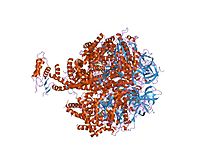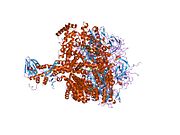ATP5E
| ATP5F1E | |||||||||||||||||||||||||||||||||||||||||||||||||||
|---|---|---|---|---|---|---|---|---|---|---|---|---|---|---|---|---|---|---|---|---|---|---|---|---|---|---|---|---|---|---|---|---|---|---|---|---|---|---|---|---|---|---|---|---|---|---|---|---|---|---|---|
 | |||||||||||||||||||||||||||||||||||||||||||||||||||
| Identifiers | |||||||||||||||||||||||||||||||||||||||||||||||||||
| Aliases | ATP5F1E, ATPE, MC5DN3, ATP synthase, H+ transporting, mitochondrial F1 complex, epsilon subunit, ATP synthase F1 subunit epsilon, ATP5E | ||||||||||||||||||||||||||||||||||||||||||||||||||
| External IDs | OMIM: 606153 HomoloGene: 128187 GeneCards: ATP5F1E | ||||||||||||||||||||||||||||||||||||||||||||||||||
| |||||||||||||||||||||||||||||||||||||||||||||||||||
| |||||||||||||||||||||||||||||||||||||||||||||||||||
| |||||||||||||||||||||||||||||||||||||||||||||||||||
| |||||||||||||||||||||||||||||||||||||||||||||||||||
| Wikidata | |||||||||||||||||||||||||||||||||||||||||||||||||||
| |||||||||||||||||||||||||||||||||||||||||||||||||||
| Mitochondrial ATP synthase epsilon chain | |||||||||
|---|---|---|---|---|---|---|---|---|---|
 ground state structure of f1-atpase from bovine heart mitochondria (bovine f1-atpase crystallised in the absence of azide) | |||||||||
| Identifiers | |||||||||
| Symbol | ATP-synt_Eps | ||||||||
| Pfam | PF04627 | ||||||||
| InterPro | IPR006721 | ||||||||
| SCOP2 | 1e79 / SCOPe / SUPFAM | ||||||||
| |||||||||
ATP synthase F1 subunit epsilon, mitochondrial is an enzyme that in humans is encoded by the ATP5F1E gene.[3][4] The protein encoded by ATP5F1E is a subunit of ATP synthase, also known as Complex V. Variations of this gene have been associated with a condition called mitochondrial complex V deficiency, nuclear 3 (MC5DN3) and papillary thyroid cancer.[5][6]
The ATP5F1E gene, located on the q arm of chromosome 20 in position 13.32, is made up of 3 exons and is 3,690 base pairs in length.[4] The ATP5F1E protein weighs 5.7 kDa and is composed of 51 amino acids.[7][8] Two pseudogenes of this gene are located on chromosomes 4 and 13.[4]
An editor has launched a copyright investigation involving this section. The text under investigation is currently hidden from public view, but is accessible in the page history. Please do not remove this notice or restore blanked content until the issue is resolved by an administrator, copyright clerk, or volunteer response agent.
The purported copyright violation copies text from https://www.ncbi.nlm.nih.gov/gene?Db=gene&Cmd=ShowDetailView&TermToSearch=514 ; as such, this page has been listed on the copyright problems page. Unless the copyright status of the text of this page or section is clarified and determined to be compatible with Wikipedia's content license, the problematic text and revisions or the entire page may be deleted one week after the time of its listing (i.e. after 16:51, 20 April 2024 (UTC)). What can I do to resolve the issue?
Steps to list an article at Wikipedia:Copyright problems:
|
Clinical significance
Mutations in the ATP5F1E gene cause mitochondrial complex V deficiency, nuclear 3 (MC5DN3), a mitochondrial disorder with heterogeneous clinical manifestations including dysmorphic features, psychomotor retardation, hypotonia, growth retardation, cardiomyopathy, enlarged liver, hypoplastic kidneys and elevated lactate levels in urine, plasma and cerebrospinal fluid.[5] Pathogenic variations have included a homozygous Tyr12Cys mutation in the ATP5E gene, which has been linked with neonatal onset complex V deficiency with lactic acidosis, 3-methylglutaconic aciduria, mild mental retardation and developed peripheral neuropathy.[11]
Reduced expression of ATP5F1E is significantly associated with the diagnosis of Papillary Thyroid Cancer and may serve as an early tumor marker of the disease.[6] Papillary Thyroid Cancer is the most common type of thyroid cancer,[12] representing 75 percent to 85 percent of all thyroid cancer cases.[13] It occurs more frequently in women and presents in the 20–55 year age group. It is also the predominant cancer type in children with thyroid cancer, and in patients with thyroid cancer who have had previous radiation to the head and neck.[14]
Interactions
ATP5F1E has been shown to have 34 binary protein-protein interactions including 28 co-complex interactions. ATP5F1E appears to interact with ATP5F1D, AGTRAP, CYP17A1, UBE2N.[15]
References
- ^ a b c GRCh38: Ensembl release 89: ENSG00000124172 – Ensembl, May 2017
- ^ "Human PubMed Reference:". National Center for Biotechnology Information, U.S. National Library of Medicine.
- ^ Tu Q, Yu L, Zhang P, Zhang M, Zhang H, Jiang J, Chen C, Zhao S (April 2000). "Cloning, characterization and mapping of the human ATP5E gene, identification of pseudogene ATP5EP1, and definition of the ATP5E motif". The Biochemical Journal. 347 (1): 17–21. doi:10.1042/0264-6021:3470017. PMC 1220925. PMID 10727396.
- ^ a b c d "Entrez Gene: ATP5F1E ATP synthase F1 subunit epsilon".
- ^ a b "ATP5F1E". Genetics Home Resource. NCBI.
- ^ a b Hurtado-López LM, Fernández-Ramírez F, Martínez-Peñafiel E, Carrillo Ruiz JD, Herrera González NE (June 2015). "Molecular Analysis by Gene Expression of Mitochondrial ATPase Subunits in Papillary Thyroid Cancer: Is ATP5E Transcript a Possible Early Tumor Marker?". Medical Science Monitor. 21: 1745–51. doi:10.12659/MSM.893597. PMC 4482184. PMID 26079849.
- ^ Zong NC, Li H, Li H, Lam MP, Jimenez RC, Kim CS, Deng N, Kim AK, Choi JH, Zelaya I, Liem D, Meyer D, Odeberg J, Fang C, Lu HJ, Xu T, Weiss J, Duan H, Uhlen M, Yates JR, Apweiler R, Ge J, Hermjakob H, Ping P (October 2013). "Integration of cardiac proteome biology and medicine by a specialized knowledgebase". Circulation Research. 113 (9): 1043–53. doi:10.1161/CIRCRESAHA.113.301151. PMC 4076475. PMID 23965338.
- ^ "ATP synthase subunit epsilon, mitochondrial". Cardiac Organellar Protein Atlas Knowledgebase (COPaKB).[permanent dead link]
- ^ "ATP synthase subunit epsilon, mitochondrial". UniProt. The UniProt Consortium.
- ^ Feniouk BA, Junge W (September 2005). "Regulation of the F0F1-ATP synthase: the conformation of subunit epsilon might be determined by directionality of subunit gamma rotation". FEBS Letters. 579 (23): 5114–8. doi:10.1016/j.febslet.2005.08.030. PMID 16154570. S2CID 84231010.
- ^ Mayr JA, Havlícková V, Zimmermann F, Magler I, Kaplanová V, Jesina P, Pecinová A, Nusková H, Koch J, Sperl W, Houstek J (September 2010). "Mitochondrial ATP synthase deficiency due to a mutation in the ATP5E gene for the F1 epsilon subunit". Human Molecular Genetics. 19 (17): 3430–9. doi:10.1093/hmg/ddq254. PMID 20566710.
- ^ Hu MI, Vassilopoulou-Sellin R, Lustig R, Lamont JP "Thyroid and Parathyroid Cancers" Archived 2010-02-28 at the Wayback Machine in Pazdur R, Wagman LD, Camphausen KA, Hoskins WJ (Eds) Cancer Management: A Multidisciplinary Approach Archived 2013-10-04 at the Wayback Machine. 11 ed. 2008.
- ^ Chapter 20 in: Mitchell, Richard Sheppard, Kumar, Vinay, Abbas, Abul K, Fausto, Nelson (2007). Robbins Basic Pathology. Philadelphia: Saunders. ISBN 978-1-4160-2973-1. 8th edition.
- ^ Dinets A, Hulchiy M, Sofiadis A, Ghaderi M, Höög A, Larsson C, Zedenius J (June 2012). "Clinical, genetic, and immunohistochemical characterization of 70 Ukrainian adult cases with post-Chornobyl papillary thyroid carcinoma". European Journal of Endocrinology. 166 (6): 1049–60. doi:10.1530/EJE-12-0144. PMC 3361791. PMID 22457234.
- ^ "34 binary interactions found for search term ATP5F1E". IntAct Molecular Interaction Database. EMBL-EBI. Retrieved 2018-11-21.
Further reading
- Viñas O, Powell SJ, Runswick MJ, Iacobazzi V, Walker JE (January 1990). "The epsilon-subunit of ATP synthase from bovine heart mitochondria. Complementary DNA sequence, expression in bovine tissues and evidence of homologous sequences in man and rat". The Biochemical Journal. 265 (2): 321–6. doi:10.1042/bj2650321. PMC 1136890. PMID 2137333.
- Elston T, Wang H, Oster G (January 1998). "Energy transduction in ATP synthase". Nature. 391 (6666): 510–3. Bibcode:1998Natur.391..510E. doi:10.1038/35185. PMID 9461222. S2CID 4406161.
- Wang H, Oster G (November 1998). "Energy transduction in the F1 motor of ATP synthase". Nature. 396 (6708): 279–82. Bibcode:1998Natur.396..279W. doi:10.1038/24409. PMID 9834036. S2CID 4424498.
- Hu RM, Han ZG, Song HD, Peng YD, Huang QH, Ren SX, Gu YJ, Huang CH, Li YB, Jiang CL, Fu G, Zhang QH, Gu BW, Dai M, Mao YF, Gao GF, Rong R, Ye M, Zhou J, Xu SH, Gu J, Shi JX, Jin WR, Zhang CK, Wu TM, Huang GY, Chen Z, Chen MD, Chen JL (August 2000). "Gene expression profiling in the human hypothalamus-pituitary-adrenal axis and full-length cDNA cloning". Proceedings of the National Academy of Sciences of the United States of America. 97 (17): 9543–8. Bibcode:2000PNAS...97.9543H. doi:10.1073/pnas.160270997. PMC 16901. PMID 10931946.
- Gross C, Kussmann S, Hehr A, Hansmann I, Schlote D (2001). "Epsilon subunit gene of F(1)F(0)-ATP synthase (ATP5E) on human chromosome 20q13.2-->q13.3 localizes between D20S171 and GNAS1". Cytogenetics and Cell Genetics. 91 (1–4): 105–6. doi:10.1159/000056828. PMID 11173840. S2CID 19946536.
- Cross RL (January 2004). "Molecular motors: turning the ATP motor". Nature. 427 (6973): 407–8. Bibcode:2004Natur.427..407C. doi:10.1038/427407b. PMID 14749816. S2CID 52819856.
External links
- Human ATP5F1E genome location and ATP5F1E gene details page in the UCSC Genome Browser.
This article incorporates text from the United States National Library of Medicine, which is in the public domain.
- All articles with dead external links
- Articles with dead external links from September 2019
- Articles with permanently dead external links
- Webarchive template wayback links
- Articles with short description
- Short description matches Wikidata
- Genes on human chromosome 20
- Wikipedia pages tagged for copyright problems
- Copied and pasted articles and sections with url provided from April 2024
- All copied and pasted articles and sections
- Wikipedia articles incorporating text from the United States National Library of Medicine
- Enzymes







